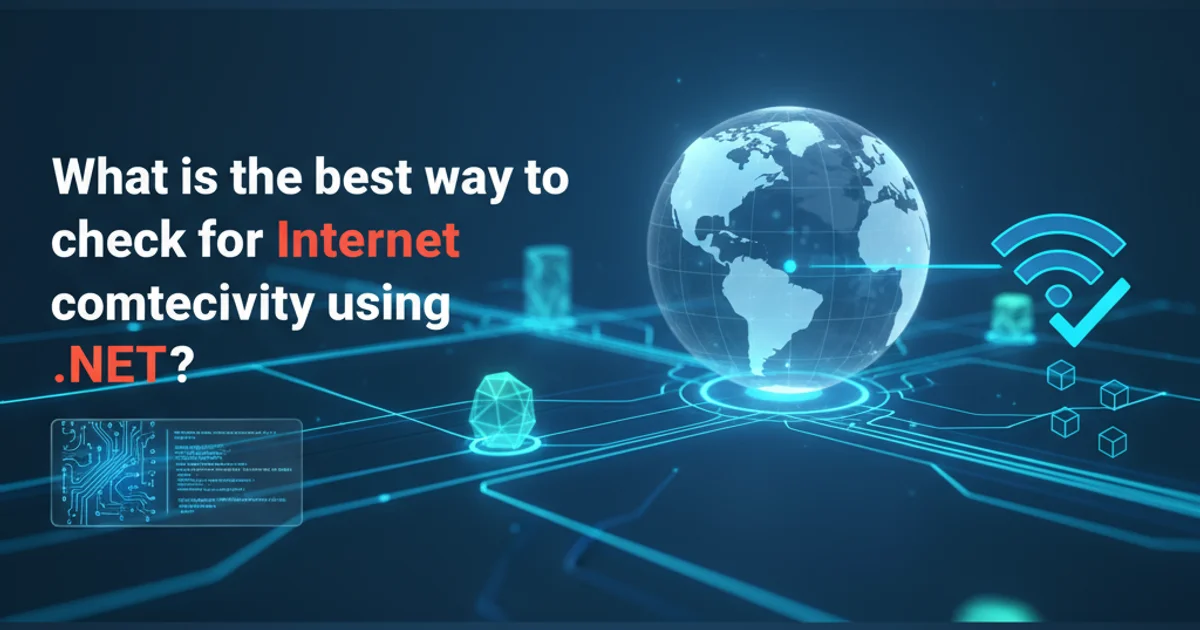What is the best way to check for Internet connectivity using .NET?
Categories:
Robust Internet Connectivity Checks in .NET: A Comprehensive Guide

Explore various methods for reliably determining internet connectivity in .NET applications, from basic pings to advanced HTTP requests, and understand their trade-offs.
Ensuring your .NET application can reliably detect internet connectivity is crucial for a smooth user experience. Whether you're building a desktop application, a mobile app with Xamarin, or a web service, knowing when you're offline allows you to gracefully handle errors, cache data, or inform the user. This article delves into different strategies for checking internet connectivity in .NET, discussing their pros and cons, and providing practical code examples.
Understanding the Nuances of 'Internet Connectivity'
Before diving into code, it's important to define what 'internet connectivity' truly means for your application. A simple network connection doesn't always guarantee internet access. For instance, a device might be connected to a local network (LAN) but lack a gateway to the wider internet, or a firewall might be blocking outbound connections. Therefore, a robust check often involves more than just verifying local network availability.
flowchart TD
A[Application Starts] --> B{Is Network Interface Up?}
B -- Yes --> C{Can Resolve DNS?}
B -- No --> F[No Local Network]
C -- Yes --> D{Can Reach External Host (e.g., Google.com)?}
C -- No --> G[DNS Resolution Failed]
D -- Yes --> E[Internet Connected]
D -- No --> H[External Host Unreachable]
F --> I[Offline]
G --> I
H --> IFlowchart of a comprehensive internet connectivity check process.
Method 1: Pinging a Known Host
One of the most common and straightforward ways to check for internet connectivity is to ping a well-known, highly available external host, such as Google's DNS server (8.8.8.8) or a major website. The System.Net.NetworkInformation.Ping class in .NET provides a simple API for this purpose. While effective, this method has limitations: some networks block ICMP (ping) requests, and a successful ping doesn't guarantee HTTP/HTTPS access.
using System.Net.NetworkInformation;
using System.Threading.Tasks;
public static class ConnectivityChecker
{
public static async Task<bool> IsInternetAvailablePingAsync(string hostNameOrAddress = "8.8.8.8", int timeoutMs = 3000)
{
try
{
using (var ping = new Ping())
{
var reply = await ping.SendPingAsync(hostNameOrAddress, timeoutMs);
return reply.Status == IPStatus.Success;
}
}
catch (PingException)
{
return false;
}
}
}
// Usage:
// bool isConnected = await ConnectivityChecker.IsInternetAvailablePingAsync();
C# code to check internet connectivity using a Ping request.
Ping can be misleading. Firewalls often block ICMP traffic, even when full internet access via HTTP/HTTPS is available. This can lead to false negatives.Method 2: Making an HTTP Request to a Reliable Endpoint
A more robust approach is to attempt an actual HTTP GET request to a known, highly available web service. This method verifies not only network connectivity but also DNS resolution and the ability to establish an HTTP connection, which is often what your application truly needs. Google's http://www.google.com/generate_204 or http://connectivitycheck.gstatic.com/generate_204 are good candidates as they return an HTTP 204 No Content status, indicating success without transferring large amounts of data.
using System.Net.Http;
using System.Threading.Tasks;
public static class ConnectivityChecker
{
public static async Task<bool> IsInternetAvailableHttpAsync(string url = "http://www.google.com/generate_204", int timeoutSeconds = 5)
{
try
{
using (var client = new HttpClient())
{
client.Timeout = TimeSpan.FromSeconds(timeoutSeconds);
var response = await client.GetAsync(url);
return response.IsSuccessStatusCode;
}
}
catch (HttpRequestException)
{
return false;
}
catch (TaskCanceledException ex) when (ex.InnerException is TimeoutException)
{
// Handle timeout specifically
return false;
}
catch (Exception)
{
return false;
}
}
}
// Usage:
// bool isConnected = await ConnectivityChecker.IsInternetAvailableHttpAsync();
C# code to check internet connectivity by making an HTTP GET request.
HttpClient instance with a short timeout. This prevents your connectivity check from hanging indefinitely if the network is truly down or extremely slow.Method 3: Combining Approaches for Maximum Reliability
For critical applications, a multi-layered approach combining both Ping and HttpClient checks can provide the most reliable determination of internet connectivity. You might start with a quick Ping to rule out obvious network issues, and if that succeeds, follow up with an HttpClient request to confirm actual web access. This reduces false positives and negatives.
using System.Net.Http;
using System.Net.NetworkInformation;
using System.Threading.Tasks;
public static class ConnectivityChecker
{
public static async Task<bool> IsInternetTrulyAvailableAsync()
{
// Step 1: Quick ping check
bool pingSuccess = await IsInternetAvailablePingAsync("8.8.8.8", 1000); // Shorter timeout for initial check
if (!pingSuccess)
{
return false; // No basic network connectivity
}
// Step 2: HTTP request to confirm web access
bool httpSuccess = await IsInternetAvailableHttpAsync("http://www.google.com/generate_204", 3);
return httpSuccess;
}
private static async Task<bool> IsInternetAvailablePingAsync(string hostNameOrAddress, int timeoutMs)
{
try
{
using (var ping = new Ping())
{
var reply = await ping.SendPingAsync(hostNameOrAddress, timeoutMs);
return reply.Status == IPStatus.Success;
}
}
catch (PingException) { return false; }
catch (Exception) { return false; }
}
private static async Task<bool> IsInternetAvailableHttpAsync(string url, int timeoutSeconds)
{
try
{
using (var client = new HttpClient())
{
client.Timeout = TimeSpan.FromSeconds(timeoutSeconds);
var response = await client.GetAsync(url);
return response.IsSuccessStatusCode;
}
}
catch (HttpRequestException) { return false; }
catch (TaskCanceledException ex) when (ex.InnerException is TimeoutException) { return false; }
catch (Exception) { return false; }
}
}
// Usage:
// bool isConnected = await ConnectivityChecker.IsInternetTrulyAvailableAsync();
C# code combining Ping and HTTP checks for robust connectivity detection.
Connectivity in Xamarin.Essentials) which often provide more efficient and accurate network status information, including reachability types (WiFi, Cellular, etc.).